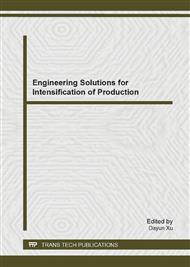[1]
Wang Hongjun, Zhang Jianmin, Xu Xiaoli. Study On Combination Trend Prediction Technology for Mechaninery System Based on SVM . Journal of vibration engineering,2006(6):242-245.
Google Scholar
[2]
Liu Xinmin, Liu Guanjun, Qiu Jing. Hybrid HMM and SVM Approach for Fault Diagnosis. Chinese journal of scientific instrument, 2006(01): 45-53.
Google Scholar
[3]
Rabiner L R. An Introduction to The Hidden Markov Models. IEEE ASSP Mag,1986(1): 4-16.
DOI: 10.1109/massp.1986.1165342
Google Scholar
[4]
B. X Xu, Q. S. Han, X. L. Xu. A Method of Trends Predictions of Machine Running Conditions Based on Hidden Markov Models. Precise manufacturing & automation. 2003(9): 11-13.
Google Scholar
[5]
Vapnik V. The Nature Of Statistics Learning Theory. New York: Springer-Verlag, 1995: 40-50.
Google Scholar
[6]
Vapnik V. Statistical Learning Theory. NewYork: JohnWiley and Sons, 1998, 102-110.
Google Scholar
[7]
C. Cortes,V. Vapnik. Support Vector Networks . Machine Learning, 1995, 20: 273-297.
DOI: 10.1007/bf00994018
Google Scholar
[8]
Yue Xia, Zhang Chunliang, Quan Yanming, Zhu Houyue. Fault Diagnosis of Nuclear-Powered Equipment Based on HMM&SVM. Nuclear power engineering. 2012(6): 104-107.
Google Scholar
[9]
Wang Hongjun, Zhang Jianmin, Xu Xiaoli. Machinery Trend Condition Support Vector Machine Intelligent Prediction. Machine tool & hydraulics. 2005(5): 170-172.
Google Scholar
[10]
Zhang Zhousuo, Li Lingjun, He Zhengjia. Research on Diagnosis Method of Machinery Fault Based on Support Vector Machine. Journal of xi'an jiaotong university. 2002, 36 (6): 116-120.
Google Scholar
[11]
Morteza Daneshkar, Reza Ebrahimi. A Novel Initialization Approach For Solving Permutation Ambiguity Of Frequency Domain Blind Source Separation. IEEE ISCI 2012, p: 189-192.
DOI: 10.1109/isci.2012.6222692
Google Scholar
[12]
Ma Jiancang, Shi Qingbin. Blind Source Separation for Nonlinearly Mixed Mechanical Vibration Signals. Noise and vibration control,2008(6): 5-8.
Google Scholar
[13]
John A, Ismial I. Analysis of Subbanding Technique in Blind Source Separation. Proceedings of SPIE - The International Society for Optical Engineering, v 6236, (2006).
Google Scholar
[14]
Tang Yan, Tang Jingtian. Removal of Ocular Artifact From EEG Using JADE. ICBBE'2007: 566-569.
Google Scholar
[15]
Nakayama, Kenji Hirano, Akihiro Horita. A Learning Algorithm for Convolutive Blind Source Separation With Transmission Delay Constraint. Proceedings of the International Joint Conference on Neural Networks, 2002, v2: 1287-1292.
DOI: 10.1109/ijcnn.2002.1007680
Google Scholar
[16]
TheodorD. Popescu. Blind Separation of Vibration Signals And Source Change DetectionApplication To Machine Monitoring. Applied mathematical modelling , 2010(34): 3408–3421.
DOI: 10.1016/j.apm.2010.02.030
Google Scholar


